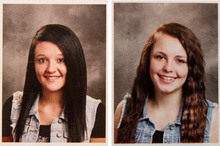This is an archived article that was published on sltrib.com in 2014, and information in the article may be outdated. It is provided only for personal research purposes and may not be reprinted.
Midway parent Melissa Milam asked her teenage son how he felt about Wasatch High's modesty guidelines, cited amid national attention as the reason girls' yearbook photos were altered to cover shoulders and raise necklines.
He responded by opening last year's yearbook to a page titled "Wasatch Stud Life."
Boys in the photos are sleeveless, with shirts pulled open to bare chests, boxer shorts are showing and a tattoo is on display. "Studs doin' what studs do best!" the page proclaims.
"I keep hearing the word 'modesty' thrown around," Milam said, referring to several girls whose shirts were digitally edited and tattoos blurred out in yearbook photos. "So the girls are supposed to be modest while the boys are supposed to be 'studs?' That's a huge double standard."
The doctored photos, released in the school's yearbook this week, have raised questions about students' freedom of expression and the role of religion in public schools.
But the most vigorous objections have come from those who see the yearbook practice as sexist. Girls whose pictures were edited described feeling "shamed" and "humiliated" and say the dress code is unevenly enforced.
Milam's 11th-grade son was "concerned" that it appears girls alone were being covered up in the yearbook, Milam said.
"I have no objection to these pictures of boys having fun," Milam said of the "stud" page, which was circulating on social media Friday. "Let's have some cool pictures of the girls, too."
A statement on the high school's website apologized for inconsistency in how students' portraits were altered and said the Heber City school and Wasatch County School District are re-evaluating the practice. But it also noted a sign warned students as they were photographed that dress code violations would be edited.
The celebration of boys as "studs" while girls' bodies are digitally covered is evidence of a bigger cultural problem, said Holly Mullen, executive director of the Rape Recovery Center in Salt Lake City.
"It speaks to allowing young men to dress and act as they choose and yet young women have to be kept in order," Mullen said.
The notion that women must be controlled and directed so as not to inflame male sexual appetites only objectifies women and can contribute to sexual assault, Mullen said.
The dynamic often plays out in sexual violence, she said. "It's a crime of control and taking away someone else's control and autonomy. It sets them [men and women] up for that down the line."
Mullen has called on the Wasatch County school board to investigate and reassess the message being sent to students.
One student whose photo was edited to add sleeves, sophomore Kimberly Montoya, said young women are not responsible for men's reactions.
"You shouldn't have to change yourself to make other people's thoughts up to their morals," Montoya said.
For student Hayley Nielsen, the fact that the school edited out a girl's dress-code-compliant tattoo shows the editing was not about the dress code, but enforcement of cultural standards.
Sophomore Shelby Baum found her photo scrubbed of a tattoo on her collarbone that says, "I am enough the way I am." The school district's dress code, written in 2002, allows tattoos as long as they are not so "conspicuous, extreme or odd" that they draw undue attention or disrupt the learning atmosphere.
"I think [the tattoo cover-up] has to do with religion more than anything," Nielsen said, referring to teachings against body art by The Church of Jesus Christ of Latter-day Saints — the dominant religious faith in Heber Valley. "It didn't violate the dress code."
Baum's mother saw irony in the fact that the school "erased" the positive message in her daughter's tattoo.
"That's what's so insane," said Bobbi Jo Wilkerson-Westergard, "The school just said 'No, you're not. We're going to edit you.' "
Nielsen's own picture was modified even though her top did not violate dress code. A black dickey was painted onto her sleeved, V-neck top, presumably in connection to the dress code's ban on "cleavage" — but no cleavage appears in the original picture, she said.
"I wore it to school numerous times," Nielsen said. "That shirt is totally modest."
While many of the students with edited photos expressed frustration about being singled out for perceived immodesty, Nielsen said she is most unhappy that she was misrepresented at all.
"I'm upset they changed my appearance," Nielsen said. "They shouldn't be able to alter our personal images without our consent."
Montoya said she feels the inconsistency of the yearbook photo alterations reflects a culture of judgment at the school. Among girls wearing similar clothing, some were edited and some were not.
"We're not good enough to be seen in the yearbook," she said. "They have to edit us to their perfect cookie-cutter mold."
Twitter: @erinalberty @KristenMoulton



